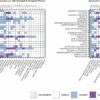Extreme rainfall events are associated with an increased risk of death from all causes as well as from heart and lung diseases, finds an analysis of data from 34 countries and regions published by The BMJ.
The health effects of extreme rainfall varied by local climate and vegetation coverage, providing a global perspective on the effect of extreme rainfall events on health.
Climate change is intensifying the frequency and severity of short term rainfall events, and emerging evidence suggests a compelling link between rainfall events and adverse health outcomes, particularly transmission of infectious diseases.
But the influence of rainfall events on cardiovascular and respiratory health, and how varying rainfall intensities affect these conditions, remains understudied.
To address this, researchers set out to examine the associations between daily rainfall (intensity, duration, and frequency) and all-cause, cardiovascular, and respiratory deaths.
They analyzed daily mortality records and rainfall data from 645 locations across 34 countries or regions on six continents, comprising a total of 109,954,744 all-cause, 31,164,161 cardiovascular, and 11,817,278 respiratory deaths from 1980 to 2020.
The main measure of interest was the association between daily deaths and rainfall events with return periods (expected intervals between events) of one year, two years, and five years.
Factors that might affect this association, such as local climate type, rainfall variability, and vegetation coverage, were also taken into account.
During the study period, a total of 50,913 rainfall events with a one year return period, 8,362 events with a two year return period, and 3,301 events with a five year return period were identified.
Overall, across all locations, a day of extreme rainfall with a five year return period was associated with an 8% increase in all-cause deaths, a 5% increase in cardiovascular deaths, and a 29% increase in respiratory deaths over a 14-day period after the rainfall event.
Extreme rainfall events with a two year return period were associated with respiratory deaths only, whereas rainfall events with a one year return period showed no effect on either cardiovascular or respiratory deaths.
Locations with lower variability of rainfall or scarce vegetation coverage showed higher risks of deaths after extreme rainfall events.
Further analysis showed protective effects of moderate to high rainfall, possibly due to reduced air pollution and people staying indoors. But risk of harm increased at extreme rainfall levels, likely due to damage to infrastructure, water contamination, and exposure to harmful microorganisms.
These are observational findings, so no firm conclusions can be drawn about causality, and the authors acknowledge that analyzed locations were mainly in east Asia, Europe, and North America, and individual factors such as age, sex, race, urban/rural residence, or specific clinical settings were not captured.
However, they say these findings underscore the need for coordinated public health strategies to mitigate the broad health effects of extreme rainfall. “This is especially important considering the well established trend of increasing short term rainfall intensity as a result of climate change,” they add.
In a linked editorial, John Ji at Tsinghua University in China welcomes the study and says health professionals are ideally placed to drive climate action by educating patients about climate-related health risks and fostering resilience within communities.
Yet, despite the clear science, he acknowledges that climate action remains difficult.
“People often forget the lessons of scarcity during times of abundance—a risky form of amnesia for climate change,” he notes. “The stakes are far too high, for when it rains, it pours—and in this era of escalating climate extremes, it will pour harder than ever before.”
More information:
Rainfall events and daily mortality across 645 global locations: two stage time series analysis, The BMJ (2024). DOI: 10.1136/bmj-2024-080944
Provided by
British Medical Journal
Citation:
Analysis finds extreme rainfall linked to heightened risk of heart and lung disease deaths (2024, October 9)



